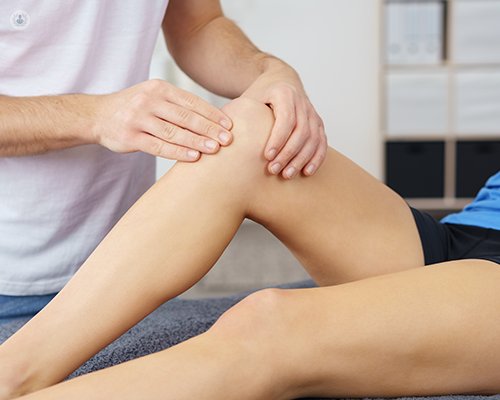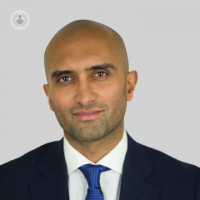How does cartilage regeneration repair damaged or lost knee cartilage?
Autore:If you find yourself with damaged or lost knee cartilage, you may be referred for one of several cartilage regeneration techniques. Mr Bilal Barkatali is a leading consultant specialist knee surgeon based in Manchester and Macclesfield and an expert in cartilage regeneration. He shares his specialist knowledge with you on cartilage regeneration (also called cartilage repair) and explains the exciting techniques used to greatly improve patients’ quality of life.

What is cartilage?
Hyaline cartilage is an amazing substance that covers the ends of bones inside of joints in humans and animals. It allows continuous and frictionless movement of the bony skeleton over a lifetime. Furthermore, the cartilage helps to transmit the load of the body to the underlying bone without causing any pain or discomfort. As it does not have any nerve endings or blood supply running through it, once it’s damaged, it has no capacity for self-healing.
What exactly is cartilage regeneration and how does it work?
Cartilage regeneration aims to regrow cartilage in the area where it has been damaged or lost. Once the cartilage has been damaged or lost, there is no covering of the bone and therefore, with every step, the body’s load is transmitted to the underlying bone and this is perceived as pain. This also results in inflammation of the joint and the surrounding cartilage can also break down. The situation can worsen and result in a degenerate joint (osteoarthritis).
Cartilage regeneration is a technique that has been developed over many decades to help restore cartilage in areas of the knee that have lost the cartilage overlying the bone. There are two types of cartilage conditions:
- There is generalised widespread cartilage damage, which is also known as osteoarthritis . In the case of osteoarthritis, the cartilage generally cannot be restored with surgery – it can only be replaced using partial or total knee replacement surgery.
- The second type of cartilage loss is something called chondral (or osteochondral) lesions. These are small and localised areas and the lesions are usually caused by trauma where a small area of cartilage has been damaged or lost. This causes pain for the individual and these can be treated successfully with cartilage regeneration.
Is cartilage regeneration different from cartilage repair?
Cartilage regeneration and cartilage repair are synonymous terms and are used interchangeably. In literature, when one refers to cartilage repair, they are also referring to cartilage regeneration procedures.
Which techniques have been proven effective?
There are four main techniques that can be used to treat chondral defects and regenerate cartilage
1. Microfracture: This is a technique where the exposed bone undergoes the microfracturing process via knee arthroscopy. This results in bleeding in the area. The blood carries stem cells through with it which slowly form a clot and over time, this turns into a new form of fibrocartilage - a scar tissue-type cartilage which doesn’t have the same properties of hyaline cartilage. This treatment is used for small, well-contained lesions which are less than 2cm squared and it works well in the short to medium-term. However, long-term results of this are not good. This is because the newly formed fibrocartilage is not able to withstand the forces that pass through it over time and ultimately, it breaks down.
2. OATS (Osteochondral autologous transplant system): This technique can be used for larger lesions of more than 2cm squared. This technique utilises small cylindrical autologous cartilage grafts - the term ‘autologous’ meaning that the cartilage is taken from the patient themselves and not a donor. What this means is that small plugs of cartilage and underlying bone are taken from the part of the joint that is not involved in weight-bearing and is, therefore, not an essential part of the joint. These plugs are then taken from the donor site and plugged into the area where there is missing cartilage. The advantages of OATS are that the transplant of hyaline cartilage (which is the perfect type of cartilage that is required to perform the function of weight-bearing) is used and that the technique can be performed in a single surgery.
3. ACI (Autologous chondrocyte implantation): This is a technique where cartilage cells are harvested from the knee joint during arthroscopic surgery. These cells are then sent to a laboratory where they are grown and expanded into a new cartilage graft. This is then implanted into the knee in a second surgery at a later date - usually 8-12 weeks after the initial surgery. The ACI technique has good to excellent outcomes and results in an excellent reduction of pain and improved quality of life. Unfortunately, a license is required to be able to culture these cells and it’s a very expensive technique requiring two different surgeries. It remains a gold standard to regenerate cartilage, but due to the health economics of the surgery, it is less commonly utilised and is less economically viable.
4. Biological allograft transplantation: This is a technique where a synthetic tissue made of hyaluronic acid or collagen is used as a graft to cover the area of lost cartilage and exposed bone. It is often combined with microfracture to allow the underlying bone cells to bleed through and turn into newly formed cartilage. The artificial graft is soaked in the patient’s own bone marrow stem cells which will then multiply and slowly turn into new hyaline-like cartilage. This type of biological allograft transplant has shown to have similar results to ACI and can be done in one surgery. It’s also more cost-effective and is currently the most exciting way to regenerate lost cartilage tissue.
For which conditions can this technique be used?
The best conditions to utilise these techniques are where cartilage damage has occurred in an otherwise healthy knee. In widespread degeneration (osteoarthritis, for example) these techniques cannot be used to regrow the cartilage as the whole joint is diseased, meaning that the technique would fail and there would be no benefit.
Quite often, patients present with a painful knee which is otherwise completely healthy and the underlying problem is damage or injury to the cartilage, which can then be repaired with cartilage regeneration.
Who is a candidate for this technique?
Anyone can have this technique utilised to help grow lost cartilage in the knee. There is no discrimination with regards to age. There are other important factors, such as alignment of the leg, patient BMI and general health to consider, and these are all assessed prior to surgery.
How long is the recovery period after surgery?
The best results are in patients who follow the rehabilitation guidelines well. Following the surgery, the area that has been treated must be protected using a brace, crutches and protected weight-bearing for six weeks followed by a rehabilitation process going on for up to six months or more. Cartilage cells are slow-growing and can take up to 18 months to fully form new cartilage. Therefore, strict adherence to rehabilitation programmes is very important.
Mr Barkatali performs all types of knee surgeries with the latest techniques. To learn how he can help you and to arrange your appointment, visit his profile – click here.


